How to independently conduct hot water and heating to the
Many still remember that the grandmother in the village, before taking a bath, had to heat the water on the stove. Today, such a "comfortable living", thanks to modern equipment, is retreating, giving way to hot water supply and heating, no different from the city one. In fact, you get a comfortable apartment with all the amenities in an ecologically clean area, and even with a plot of land.
But how to achieve this all?
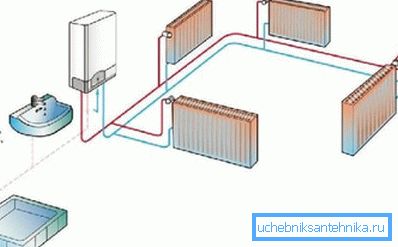
In this case, we will tell you how not to depend on utilities. You do not need a city heating hotline, because you will regulate it yourself.
First step
Before heating the house with hot water, it is necessary to: select the appropriate scheme:
- pick up to her the necessary elements;
- purchase tools and materials for work.
Now you just have to assemble the system with your own hands, using skills and knowledge.
Schema selection
The heating system with hot water can be arranged in different ways:
- use the "Leningrad" or hold one pipe around the perimeter;
- use a more reliable - two-pipe or collector version;
- coolant circulation should be left natural or still interfere in the process and install a circulation pump.
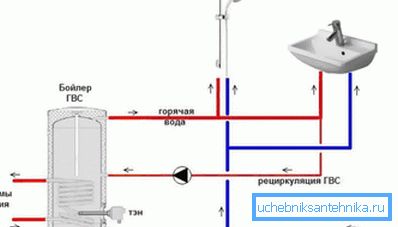
Consider the difference between the options among themselves:
| Monotube |
|
| Twin tube | The advantages of the scheme:
The disadvantage is a lot of pipes and connections. In fact, it fully pays off the advantages of this system during operation. |
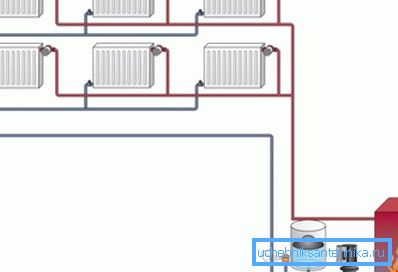
The forced heating system uses a circulating pump, therefore it is considered volatile. The device allows you to increase the speed of the coolant, which can reduce the diameter of the pipe.
Tip: in order to make the mechanical heating system universal, make a bypass on the return pipe and install a circulation pump on it. In the event of a power outage, simply open the shut-off valve on the return line, making the circulation natural.

We select items
The main should include:
- heat generator (boiler or stove);
- pipes of different diameters, trunk pipes — large, supply to batteries — smaller;
- radiators;
- circulation pump;
- accumulative capacity for hot water;
- expansion tank;
- thermostats and controllers;
- valves and fasteners.
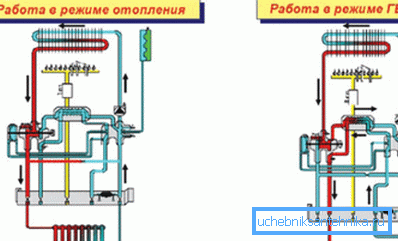
The most important device in the heating system and hot water is a heat generator.
Before choosing, you should know:
- What you need power unit, which must be determined by the heat capacity and heat loss of the rooms, the overall size of the building and the minimum temperature in winter.
- What kind of fuel will it be used for:
- solid - coal, wood, peat, briquettes or pellets;
- gaseous;
- liquid;
- electricity.
The most popular and most convenient option is a gas boiler. In order to use it to establish hot water in the house, it is necessary to purchase a double-circuit design. Between themselves, they are not connected in any way, so the heating circuit can be filled with either water or antifreeze.
Tip: you should choose only certified antifreeze for domestic use, otherwise you can buy a fake, which will damage the heating system.
Modern heat generator for heating systems is a fully automated device that has an indication of all the necessary data. If the external conditions change, he will adjust the pressure and temperature parameters to maintain the desired mode.
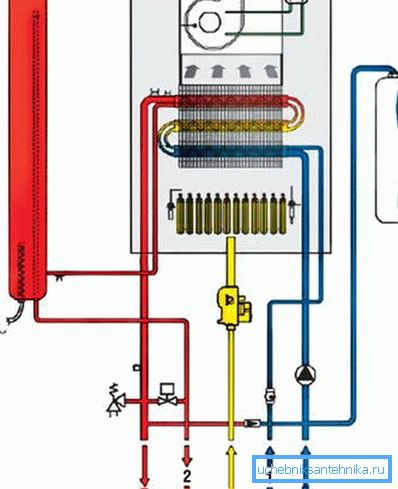
Electric boilers are gaining popularity today, the main advantage of which is:
- small overall dimensions;
- possibility of installation in any convenient place.
Minus - dependence on electricity, which is usually unstable in rural conditions.
Tip: if the interruption of electricity does not occur so often, you can buy a UPS and connect the electric boiler through it. Then you will have time to wait for the electricity to reappear, or to use an electric generator using liquid fuel.
Installation
In addition to electricity, the benefits of civilization in a country house is considered to be heating and hot water. For their supply should go through several stages. If you do not use a gas boiler, you can exclude obtaining permits.
After the scheme has been defined, materials and components have been acquired, it is necessary to assemble everything into one coherent system:
- Find a place to install the boiler. It is advisable to use for this a separate room or a free corner. Instructions for installing the equipment usually prescribe the recommended parameters.
- The next stage - fixture radiators. They can be cast iron, steel, aluminum or bimetallic, so choose the appropriate elements and the appropriate depth of the holes.
Tip: pay more attention to the fixture of cast iron batteries, because they are the most bulky and heavy.
From the wall back 50 mm, 50-100 mm from the floor and window sill.
Tip: we recommend to install on the wall, which will close the radiator, a layer of insulation with aluminum foil into the room.
- When installing a circulation pump, you must install a filter in front of it to collect mechanical particles, protecting the device from clogging. For easy replacement or preventive maintenance, install valves on both sides of the device.

- At the last stage, connect the nodes and devices with pipelines. You can use metal, polypropylene and metal-plastic products of various thickness and diameter. Most often today use plastic, due to the ease of its installation, reducing the weight of the system, design and a good combination of price and quality.
- If you do not want to install a double-circuit boiler, hot water supply can be obtained using a storage tank, a flow-through electric heater or a storage tank with a metal heat exchanger, which is specifically removed from the heat generator in a separate circuit.
Conclusion
Today we have considered various options for organizing heating and hot water. Although the installation is complex and is associated with a variety of works, it can be done independently with the necessary tools and materials.
Take the time to not make mistakes, for the correction of which will have to completely dismantle the system. Video in the article will provide an opportunity to find additional information on the above topic.